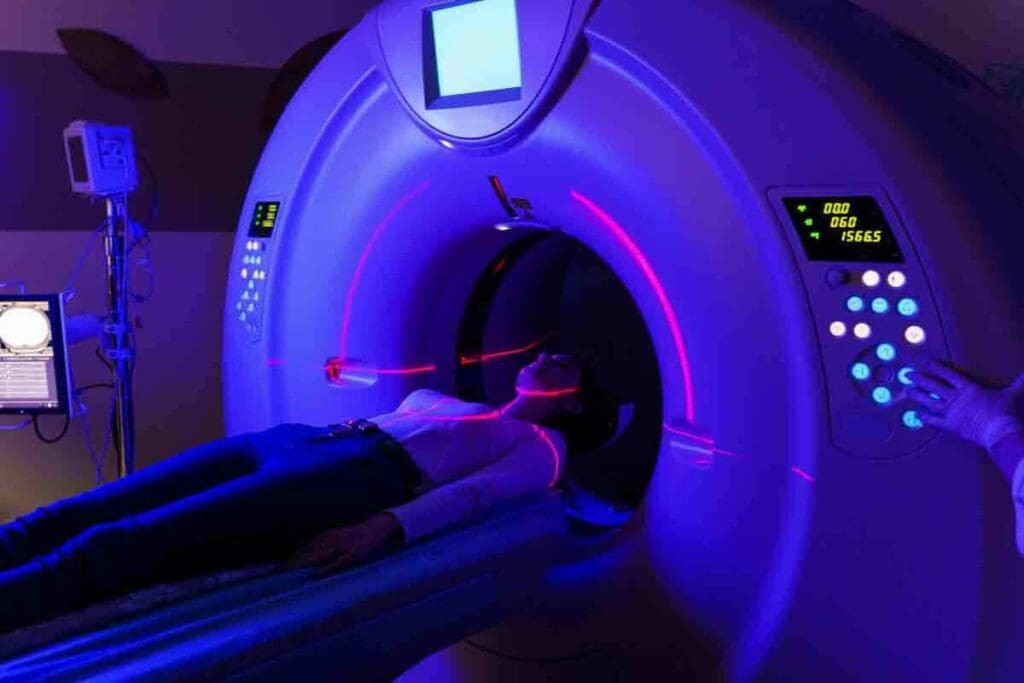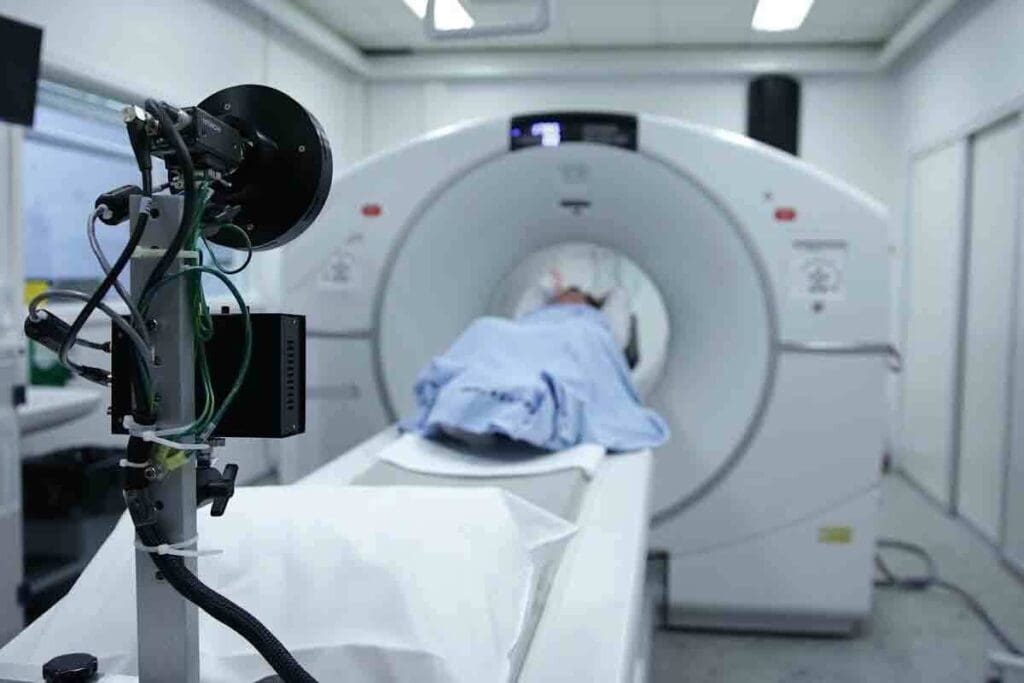Last Updated on November 27, 2025 by Bilal Hasdemir

We are leading a revolution in fighting cancer with XRT treatment. XRT treatment, or radiation therapy, uses targeted radiation to kill cancer cells. It helps control tumor growth. This treatment is a key part of modern cancer care, found in trusted centers with the latest technology and a focus on patients.
At the core of this approach is a dedication to excellence. If you or a loved one is facing cancer treatment options, knowing about radiotherapy is important. We offer full care that meets medical needs and provides emotional support and guidance during treatment.
Key Takeaways
- Radiotherapy is a critical component of modern cancer care.
- XRT treatment uses targeted radiation to destroy malignant cells.
- Trusted cancer centers integrate the latest radiation technologies with patient-centered care.
- Radiation therapy is a powerful tool in controlling tumor growth.
- Comprehensive care includes emotional support and guidance throughout treatment.
Understanding XRT Treatment: Definition and Fundamentals

Understanding XRT treatment is key for those facing cancer. XRT, short for X-ray therapy, has a long history in fighting cancer. Today, it’s a major part of oncology, helping treat many cancers.
What XRT Stands For in Medical Terminology
XRT means X-ray therapy, a term from the early days of cancer treatment. Now, XRT is another word for radiation therapy or radiotherapy. It uses high-energy rays to kill cancer cells.
The Role of XRT in Modern Oncology
XRT is used in many ways to fight cancer. It can be the main treatment, or it can help after or before other treatments. The National Cancer Institute says XRT is key. It targets tumors well, while keeping healthy tissue safe.
Here’s how XRT is used in oncology:
| Therapy Type | Description | Cancer Types |
| Curative | The aim is to cure the cancer | Early-stage cancers |
| Adjuvant | Used after primary treatment to eliminate remaining cancer cells | Breast, prostate, and colon cancers |
| Neoadjuvant | Given before primary treatment to shrink tumors | Locally advanced cancers |
| Palliative | Relieves symptoms and improves quality of life | Advanced cancers |
How XRT Treatment Works Against Cancer

XRT treatment is a key part of cancer therapy. It uses ionizing radiation to fight cancer cells. This method targets cancer cells well.
The Science of Ionizing Radiation
Ionizing radiation is a powerful form of energy. It can remove electrons from atoms, creating ions. This damage harms the DNA of cancer cells, stopping them from growing and leading to their death.
Types of Ionizing Radiation:
- X-rays
- Gamma rays
- Particle radiation (e.g., electrons, protons)
Targeting Malignant Cells While Sparing Healthy Tissue
One big challenge in radiation therapy is hitting the tumor hard but not harming nearby healthy tissues. Intensity-Modulated Radiotherapy (IMRT) and Image-Guided Radiation Therapy (IGRT) help with this.
Radiation Dose Considerations and Planning
Planning is key to making sure the radiation dose is right for the tumor. We consider the total dose, how it’s given, and how long treatment lasts.
“Radiation therapy uses high-energy rays or particles to kill cancer cells.” This basic idea is why XRT treatment is so effective in fighting cancer.
Advanced XRT Techniques in Modern Radiotherapy
Advanced XRT techniques are changing cancer treatment for the better. They make treatments more precise and effective. Modern External Beam Radiation Therapy (EBRT) focuses radiation on tumors, protecting healthy tissues nearby.
Intensity-Modulated Radiotherapy (IMRT)
Intensity-Modulated Radiotherapy (IMRT) is a cutting-edge radiation therapy. It changes the intensity of the radiation beam. This method lets us give higher doses to tumors while keeping nearby healthy tissues safe.
Benefits of IMRT:
- Enhanced precision in targeting tumors
- Reduced side effects due to lower doses to the surrounding tissues
- Ability to treat complex tumor shapes effectively
Three-Dimensional Conformal Radiation Therapy (3D-CRT)
Three-Dimensional Conformal Radiation Therapy (3D-CRT) uses imaging to create a 3D model of the tumor. It allows for radiation beams that match the tumor’s shape closely.
The advantages of 3D-CRT include:
- Improved tumor targeting
- Reduced radiation exposure to healthy tissues
- Better treatment outcomes due to more precise radiation delivery
Image-Guided Radiation Therapy (IGRT)
Image-Guided Radiation Therapy (IGRT) combines imaging with radiation delivery. It checks the tumor’s position in real-time, ensuring accurate radiation.
Key features of IGRT:
| Feature | Description | Benefit |
| Real-time imaging | Allows for verification of tumor position during treatment | Enhanced accuracy |
| Adaptive treatment planning | Enables adjustments to treatment plans based on changes in tumor size or position | Improved treatment efficacy |
| Precision radiation delivery | Ensures that radiation is delivered precisely to the tumor | Reduced side effects |
These advanced XRT techniques are big steps forward in radiotherapy. They offer better results for patients with different cancers.
Types of Cancer Effectively Treated with XRT
XRT treatment is versatile and effective for many cancers. It targets cancer cells well while protecting healthy tissue. This makes it a good choice for prostate, breast, and lymphoma cancers.
Prostate Cancer Radiotherapy Approaches
Prostate cancer is a common cancer treated with XRT. Radiotherapy approaches include external beam radiation therapy (EBRT) and brachytherapy. EBRT uses high-energy rays from outside the body. Brachytherapy places radioactive material inside the prostate.
We use advanced techniques like Intensity-Modulated Radiotherapy (IMRT). This method targets the tumor precisely. It helps reduce side effects and improve results.
Breast Cancer XRT Protocols
Breast cancer treatment often includes XRT after surgery. Breast cancer XRT protocols depend on the cancer’s stage and type. They also consider the patient’s health. Whole-breast irradiation is common, with some patients getting accelerated partial breast irradiation (APBI).
Our radiation oncology teams work with surgeons and medical oncologists. They create personalized treatment plans. These plans aim to improve outcomes and reduce long-term side effects.
Lymphoma and Other Responsive Malignancies
Lymphoma, including Hodgkin and non-Hodgkin types, can be treated with XRT. The treatment depends on the lymphoma’s stage, location, and the patient’s health. XRT is also used for head and neck cancers, lung cancer, and brain tumors.
We use the latest radiotherapy advancements. We tailor treatment to each patient’s needs. This approach aims to improve outcomes.
The Complete XRT Treatment Process for Patients
XRT treatment is a detailed process that needs careful treatment planning, precise delivery, and ongoing patient care. We know it can be tough for patients to navigate this. So, we’re here to guide and support you every step of the way.
Initial Consultation and Treatment Planning
The XRT treatment starts with an initial consultation. Our team of radiation oncologists and specialists will assess your condition and choose the best treatment. They’ll look at your medical history, discuss options, and outline your treatment schedule.
Research on the National Institutes of Health website shows that effective treatment planning is key to good outcomes in radiation therapy.
We also address any questions or concerns you might have. This ensures you’re fully informed about your treatment. Our team works with you to create a treatment plan that fits your needs and situation.
Simulation and Mapping Procedures
After the initial consultation, we move on to the simulation and mapping procedures. We use advanced imaging like CT scans to locate the tumor and define the treatment area. This step is vital for accurate radiation delivery and protecting healthy tissues.
Our facilities are equipped with the latest technology. This allows us to perform complex simulations and create detailed treatment maps. This phase is critical for the success of your XRT treatment.
Treatment Schedule and Delivery
Once the treatment plan is set and the simulation is done, we start the XRT treatment. The treatment schedule is planned carefully, with sessions tailored to your needs. Our team ensures the treatment is delivered precisely as planned, using advanced equipment.
We monitor your progress closely and adjust the treatment plan if needed. Our goal is to provide effective patient care and support. This helps minimize side effects and maximize treatment outcomes. By understanding what is in radiation therapy is and how it’s administered, you can feel more confident and prepared for your treatment journey.
Therapeutic Approaches Using XRT Treatment
XRT treatment has changed cancer care a lot. It has many ways to fight cancer. We use XRT based on the cancer type, stage, and where it is. We also consider the patient’s health.
Primary Curative Radiotherapy
Primary curative radiotherapy is the main treatment to cure cancer. It’s used for tumors that radiation can kill. Curative radiotherapy can be used alone or with other treatments for better results.
For example, early-stage prostate cancer can be cured with curative radiotherapy. This treatment has few side effects.
Adjuvant and Neoadjuvant Applications
XRT is also used as adjuvant therapy after surgery. It kills any cancer cells left behind. This lowers the chance of cancer coming back.
On the other hand, neoadjuvant radiotherapy is used before surgery. It makes tumors smaller and easier to remove. This method helps in many cancers, like breast, rectal, and head and neck cancers.
Palliative XRT for Symptom Management
When a cure is not possible, XRT is used for palliative care. It aims to ease symptoms and improve life quality for patients with advanced cancer. Palliative radiotherapy can lessen pain, bleeding, and other symptoms.
This use of XRT is key in helping patients with cancer. It gives relief and comfort when they need it most.
In summary, XRT treatment is a powerful tool in cancer care. It offers different treatments based on each patient’s needs. Whether for cure, as part of a treatment plan, or for comfort, XRT is essential in fighting cancer.
Side Effects and Management in XRT Treatment
XRT is a key treatment for many cancers. Yet, it can lead to side effects that affect patients’ daily lives. These effects can happen during or after treatment. Their severity depends on the dose and area treated.
Common Acute Side Effects
Acute side effects of XRT treatment appear soon after starting therapy. They can include:
- Fatigue: Many patients feel tired during XRT. Rest and pacing activities can help manage this.
- Skin Reactions: The treated skin may turn red, get irritated, or feel sensitive. Gentle care and avoiding harsh products can help.
- Hair Loss: Hair loss is possible, depending on the treated area. It’s usually temporary, but regrowth timing varies.
Potential Long-Term Effects
Long-term side effects from XRT treatment can include:
- Fibrosis: Scarring in the treated area can cause stiffness and limited mobility.
- Secondary Cancers: Though rare, there’s a chance of getting secondary cancers in the treated area years later.
- Organ Damage: The dose and location of XRT can pose risks to nearby organs, like the heart or lungs.
Strategies to Minimize Toxicity
To lessen XRT side effects, several strategies can be used:
- Advanced Treatment Planning: IMRT and IGRT target tumors precisely, reducing harm to healthy tissues.
- Supportive Care: Nutritional counseling, physical therapy, and psychological support can help patients.
- Follow-Up Care: Regular check-ups with healthcare providers are key to managing side effects.
Understanding XRT side effects and using strategies to manage them can help patients through their treatment.
Combining XRT with Other Cancer Therapies
XRT treatment can be combined with other cancer therapies to improve patient outcomes. This approach tailors treatment to each patient’s needs. It can make treatments more effective and reduce side effects.
Combining XRT with other therapies is becoming more common in cancer treatment. “The future of cancer treatment lies in combination therapies,” says a medical expert, a leading oncologist. “We can use the strengths of multiple modalities to achieve better outcomes.”
Concurrent Chemoradiation Approaches
Chemoradiation combines chemotherapy and radiation therapy to treat cancer. This approach is effective for cancers like cervical, head and neck, and some lung cancers. It delivers chemotherapy and XRT at the same time to boost their effectiveness.
The benefits of concurrent chemoradiation include:
- Enhanced tumor kill due to the synergistic effects of chemotherapy and radiation
- Potential for improved local control and overall survival
- Ability to target micrometastatic disease with chemotherapy while addressing the primary tumor with XRT
Sequencing with Surgery
XRT can be used with surgery to improve treatment outcomes. The order of these treatments depends on the cancer type, stage, and patient health.
Neoadjuvant XRT, given before surgery, can shrink tumors. This makes them easier to remove and preserves more healthy tissue. Adjuvant XRT, given after surgery, targets any remaining cancer cells to reduce recurrence risk.
“The strategic use of XRT before or after surgery has revolutionized the treatment of many cancers. It offers patients better chances of cure and improved quality of life.”
Integration with Immunotherapy and Targeted Agents
Combining XRT with immunotherapy and targeted agents is a promising area in cancer treatment. This combination can enhance anti-tumor immune responses and improve outcomes.
Research shows XRT can make tumors more susceptible to immunotherapy. Targeted agents can also be used with XRT to enhance its effectiveness or reduce side effects.
As we learn more about cancer biology and treatment interactions, combining XRT with other therapies will become more important in cancer care.
Recent Research and Effectiveness of XRT
New studies show XRT is helping more cancer patients live longer and feel better. Researchers are working to make XRT better by reducing side effects.
Dose Escalation Studies in Prostate Cancer
Research on XRT dose levels has focused on prostate cancer. It shows that higher doses can improve treatment results and lower the chance of cancer coming back.
A study in a top oncology journal found that doses over 78 Gy helped more men with prostate cancer. This was better than lower doses.
| Dose Level | Biochemical Control Rate | Recurrence Rate |
| <78 Gy | 70% | 30% |
| ≥78 Gy | 85% | 15% |
Hypofractionation Approaches
Hypofractionation, or giving more radiation in fewer sessions, is being studied. It might make treatment easier and more effective for some cancers, like prostate cancer.
A trial compared hypofractionated XRT to traditional XRT in prostate cancer. It found both methods worked well, with similar benefits and side effects.
Quality of Life Outcomes
Quality of life is key in cancer treatment. XRT is beneficial in this area. Studies look at how XRT affects symptoms and long-term side effects.
Modern XRT methods, like IMRT, are being used to reduce side effects and keep the quality of life high. A study on prostate cancer patients treated with IMRT found they were very satisfied and had few long-term side effects.
As XRT evolves, more research will help us understand its best use in cancer treatment.
Future Innovations in Radiotherapy and XRT
Looking ahead, radiotherapy and XRT are set to change cancer treatment. New technologies and a better understanding of cancer are driving these changes. We aim to make treatments more effective and reduce side effects.
Artificial Intelligence in Treatment Planning
Artificial intelligence (AI) is changing how we plan radiotherapy. AI looks at lots of data to make treatment plans better. This makes radiation more precise and tailored to each patient.
AI also helps doctors by doing some tasks for them. This lets them focus more on caring for patients. Using AI in radiotherapy is a big step towards precision medicine.
Biological Response Modifiers
Biological response modifiers are another innovation in radiotherapy. These agents make cancer cells more vulnerable to radiation. This can lead to better treatment results and lower doses of radiation, reducing side effects.
Scientists are studying these modifiers for different cancers. Adding them to radiotherapy could make treatments even more effective.
Personalized Radiation Medicine
The future of radiotherapy is personalized radiation medicine. This means treatments are made just for each patient’s cancer. Advanced imaging and genetic tests help create these personalized plans.
Personalized medicine will lead to better results for patients. It also allows for combining treatments in new ways. This could include radiotherapy with immunotherapy and targeted therapy.
In summary, radiotherapy and XRT are on the verge of major changes. Innovations in AI, biological response modifiers, and personalized medicine will greatly improve treatment outcomes. As these technologies advance, we can expect better care and quality of life for patients.
Conclusion: The Evolving Impact of XRT in Cancer Care
XRT treatment is a key part of cancer care. It offers hope to patients all over the world. Thanks to new radiotherapy techniques, XRT is making cancer treatment better.
Radiation therapy is getting better, thanks to new ideas. We’ve seen big steps forward in XRT, like better precision and results. As we keep learning, XRT will stay a top choice for fighting cancer.
The future of XRT in cancer care is bright. New tech like AI and personalized medicine are coming. XRT will keep getting better, helping more people fight cancer.
FAQ
What does XRT stand for in medical terminology?
XRT stands for External Beam Radiation Therapy. It’s a cancer treatment that uses high-energy rays to kill cancer cells.
What is the role of XRT in modern oncology?
XRT is key in modern oncology. It offers a non-invasive treatment for many cancers. It can be used alone or with other therapies.
How does XRT treatment work against cancer?
XRT treatment damages cancer cells’ DNA with ionizing radiation. This stops them from dividing and leads to their death.
What are the advanced XRT techniques used in modern radiotherapy?
Modern radiotherapy uses advanced XRT techniques. These include IMRT, 3D-CRT, and IGRT. They improve treatment accuracy and reduce side effects.
What types of cancer can be effectively treated with XRT?
XRT treats many cancers. This includes prostate, breast, lymphoma, and more. It depends on the cancer’s stage and location.
What is the complete XRT treatment process for patients?
The XRT treatment process starts with a consultation. It includes planning, simulation, and treatment delivery. It’s usually done on an outpatient basis.
What are the therapeutic approaches using XRT treatment?
XRT has several uses. It can be used as primary treatment, adjuvant, or neoadjuvant. It can also be used for symptom management, depending on the patient’s needs.
What are the common side effects of XRT treatment?
Side effects of XRT include fatigue and skin reactions. Localized side effects also occur. Long-term effects vary based on the dose and treatment area.
Can XRT be combined with other cancer therapies?
Yes, XRT can be combined with other treatments. This includes chemotherapy, surgery, immunotherapy, and targeted agents. It aims to improve treatment outcomes and patient care.
What is the current research on the effectiveness of XRT?
Research on XRT is ongoing. It includes studies on dose escalation, hypofractionation, and quality of life. These studies aim to optimize XRT treatment and improve patient outcomes.
What are the future innovations in radiotherapy and XRT?
Future innovations include artificial intelligence and personalized radiation medicine. These advancements are expected to enhance treatment precision and effectiveness.
What is radiation therapy?
Radiation therapy is often abbreviated as RT or XRT. XRT refers to External Beam Radiation Therapy.
What is radioterapia oncologica?
Radioterapia oncologica, or radiation oncology, is a medical specialty. It uses radiation to treat cancer. The goal is to cure or control the disease while protecting healthy tissues.
References
- National Cancer Institute. (2018, April 30). External Beam Radiation Therapy for Cancer. https://www.cancer.gov/about-cancer/treatment/types/radiation-therapy/external-beam






